...to the Aquarius Challenge, with Commentary |
back2 Orts |
back to the top of Alison |
back2 W/land |
|
| The Aquarius Challenge | Some Discussion Points (w/o Solutions) |
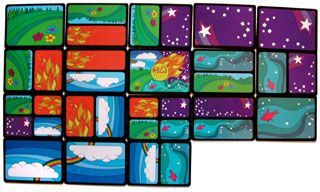 |
Here's my sample layout, for reference... This page has some solutions by Elliot Evans, and some of the observations that emerged from our correspondence about his efforts. For those of you who'd like know some of the questions that arose from his submissions without seeing his layouts, I've tried to distill out some discussion points and questions. They are considerably more challenging to think about than this simple commentary, so check 'em out. If you want to read just the text on this page (which is different than the discussion points) but you don't want to look at the pictures, you can scroll sideways until the pictures aren't showing (they're all on the right side). |
Some Solutions:
|
...and Commentary
|
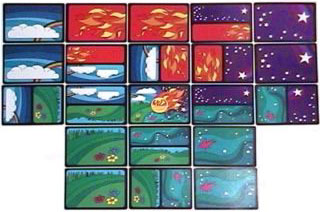 |
This is Elliot's first effort, and it's relatively straightforward. "I'd say [this one] is the 'reference' design. It's very methodical, and to beat it you have to start getting clever," he says. It's not the smallest layout by any means, but it is elegant in its simplicity: Each element radiates out from the center, which is to say, none of the groupings cross the wild card. This means that each element touches only two other elements, and for each neighbor, both of the available duo panels are used. These make up four of the panels for each element. Both full panels (monos) are used, plus the one from the wild card makes seven. This is true for each element in this layout. Elliot would also like you to note another elegant quality this layout possesses. Do you see it? I didn't, until it was pointed out, despite the fact that in my initial layouts I attempted this conceit as well... |
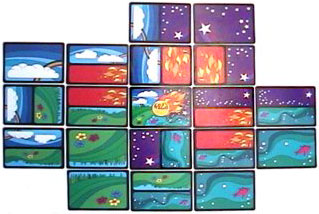 |
The simplicity and elegance of that first solution led me to believe that perhaps 21 was the smallest layout with no wasted panels that could be achieved without using quads. Elliot quickly disproved this by example. Of course! I had forgotten that by crossing the wild card, an element may have more than two neighbors, and therefore, more duos are available, and you can achieve a layout of less than 21 cards without quads. I restated my theorem to include crossing the wild card. Actually, the fact that he didn't cross the wild card is probably more important than the fact that he used no quads. I don't think you can use quads without wasting panels unless you cross the wild card. Which makes the theory: 21 is the smallest no-waste layout that can be achieved without crossing the wild card. Elliot points out, "The wild card has eight 'sites', which means up to three elements can occupy two sites. Maximum density layouts will be very mixed-up, so having the same element touching two adjacent sites is a waste." |
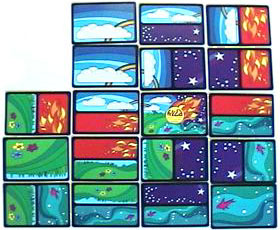 |
Same number of cards as mine, but no wasted panels! Notice that this arrangement still does not use any quads. Both of my wasted panels were on the two quads, and Elliot had similar problems in some of his undocumented attempts. I wondered if it was possible to use quads without wasting a panel. Quads are very difficult to use because, as some of you may have noticed, not all possible quads exist in the deck. The number of possible arrangements of 4 out of 5 elements was prohibitively high for us to include them all. (Extra credit question: how many possible quads are there?) Elliot brings this up too, saying,"I'm sure that with a buttload of analysis somebody could figure out which ones are the best to use." I don't think there are some quads that are "better" than others, rather that the challenge is to find the solutions which use the quads available to us. Most of us will probably resort to trial and error. |
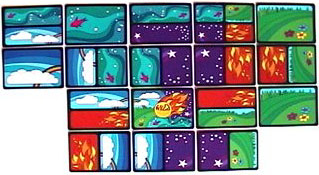 |
...but let's not knock trial and error! A beautiful solution! I went back and added info about the number of quads and monos in each layout, too, because it's interesting to watch their numbers change with increasing efficiency. I'm sure there are other solutions equal to or possibly smaller than this one. I encourage everyone to give it a try. It's a fun solitaire challenge, and at the very least you'll spend some time getting to know your Aquarius deck. Check out the points for discussion. There are further questions that arise from these examples. I'd love to see new solutions that show other cases. |
| --- Copyright © 2004 by Alison Frane --- |